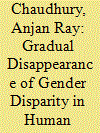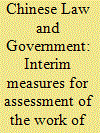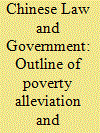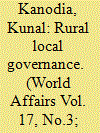|
|
|
Sort Order |
|
|
|
Items / Page
|
|
|
|
|
|
|
| Srl | Item |
| 1 |
ID:
120749


|
|
|
|
|
| Publication |
2013.
|
| Summary/Abstract |
This study systematically explores the factors that affect collective identity associations within the Alevi community in Turkey by employing the social identity approach and examining survey data collected through fieldwork. The results show that Kurdish Alevis express lower levels of attachment to their religious identity as compared to Turkish Alevis. The results also indicate that personal experiences of discrimination tend to increase one's prioritization of Alevi identity. Last, no significant differences are observed regarding group identity between Alevis who reside in urban areas and those who live in rural areas.
|
|
|
|
|
|
|
|
|
|
|
|
|
|
|
|
| 2 |
ID:
090110


|
|
|
|
|
| Publication |
2009.
|
| Summary/Abstract |
This paper investigates the impacts of financial intermediary (or banking) development on village-level per capita income using a Chinese dataset for selected years between 1993 and 2006. The empirical results from a random effect regression model indicate that mean per capita income in rural villages follows an inverted U-shaped path as financial intermediation develops. However, using a pooled quantile regression approach, we find that median per capita income in rural villages follows a positive linear path, rather than an inverted U-shaped path, as financial intermediation develops. The positive linear effect of financial intermediary development is observed at the lower and higher ends of the conditional per capita income distribution. This suggests that development of financial intermediation in China might not have statistically significant differential effects in low-income or high-income rural villages.
|
|
|
|
|
|
|
|
|
|
|
|
|
|
|
|
| 3 |
ID:
175111


|
|
|
|
|
| Summary/Abstract |
This study examines the existence and persistence of gender disparity in education in rural and urban India. We use the sequential logit model of regression on data sets provided by three rounds of quinquennial employment and unemployment surveys conducted by the National Sample Survey Office (NSSO). The findings of the study reveal that in both rural and urban sectors of India there is gender group disparity, and this disparity is greater in the rural sector than in the urban areas. Furthermore, it is also found that the gender groups’ disparity in education in India has substantially changed during the last two decades across both sectors.
|
|
|
|
|
|
|
|
|
|
|
|
|
|
|
|
| 4 |
ID:
145130


|
|
|
|
|
| Summary/Abstract |
This paper provides insights into the local political economy of China’s current in situ urbanisation as compared to the 1980s and 1990s, focusing on the role played by county and township governments in shaping urbanisation in their localities. Marked differences were observed in the extent to which local cadres are able to steer the urbanisation process and adapt the relevant policies to local conditions and demands of the population. If leading county and township cadres are able to assert a relatively autonomous position vis-à-vis the superior municipality, a rural urbanisation process that considers both urban and rural interests and integrates local economic initiatives seems to become a potential alternative to the prevailing city-centred urban expansionism.
|
|
|
|
|
|
|
|
|
|
|
|
|
|
|
|
| 5 |
ID:
114884


|
|
|
| 6 |
ID:
180077


|
|
|
|
|
| Summary/Abstract |
As post-growth Japan hesitates between stagnation and change, its young people are opting out of traditional career paths and seeking lifestyles with greater personal freedom. The COVID-19 pandemic has forced Japanese society to change in some respects, but institutional and corporate leaders remain reluctant to embrace reforms to work and gender norms and in many other areas. Yet social changes are occurring at the grassroots level, as younger Japanese pursuing new opportunities are moving from cities to the countryside, others head overseas in pursuit of more diverse careers and living arrangements, and some among the growing ranks of social introverts turn themselves into successful game developers and writers.
|
|
|
|
|
|
|
|
|
|
|
|
|
|
|
|
| 7 |
ID:
140842


|
|
|
|
|
| Summary/Abstract |
China’s main comparative advantage in international competition is its cheap labour, mostly migrant workers from rural areas. Migrant workers play an important role in the economic development of China. Since 1978 when China began to adopt the reform and opening-up policy, more and more migrant workers have poured into cities and towns to seek better employment opportunities. However, besides low wages, they have to endure long working hours and dangerous working environments. In addition, many employers do not contribute social insurance for migrant workers at all, leaving them vulnerable to unexpected living costs. According to a survey conducted in the Yangtze Delta Region by the Legal Aid Program for Migrant Workers at Nanjing University in August 2009, only 39.3 per cent of migrant workers have pension schemes, and 31.5 per cent of migrant workers have not joined any social insurance schemes of any sort. In some cities such as Wenzhou, even fewer are covered, as only 15.4 per cent of migrant workers have a pension scheme and 50 per cent of migrant workers have not joined any social insurance scheme. When migrant workers become old, sick, unemployed or injured in industrial accidents, they fall into poverty because they cannot apply for social insurance benefits. Among these problematic issues, old-age insurance should be specifically highlighted because more migrant workers are reaching their retirement age. There has been an increasing number of pension cases filed at the courts of law. However, many courts refuse to proceed with the hearings of these social insurance cases, or apply inappropriate legal doctrines in the trial process. It is also almost impossible for migrant workers to get legal redress for their pension benefits when their employers fail to comply with the law and contribute fees for them. It is imperative for the Chinese government to unify the old-age insurance system countrywide.
|
|
|
|
|
|
|
|
|
|
|
|
|
|
|
|
| 8 |
ID:
097271


|
|
|
|
|
| Publication |
2010.
|
| Summary/Abstract |
The region of Valencia has a marked territorial duality: an urbanised, populated and high-income coastal line, and mountain and depressed inland rural areas. This territorial duality also derives in a functional duality, so that market and regulation drivers seem to assign rural areas specific roles for the provision of raw materials, energy, water, and the like. One of the clearest examples can be found in the design and development of the Wing Energy Plan passed by the Regional Government in 2001, which designated areas for the installation of windmills. However, this regulation has resulted in an outstanding emergence of associations that have organised at several levels (from the local to the national) as a strong opposition movement to the local developments of the Plan.
With this background, the objective of this paper is to analyze, from a set of case studies, the processes of emergence and the evolution of collective actors (associations) which have been arising in many rural areas as a response to the local applications of the Wind Energy Plan. Attention will be paid to understand the tactics used, the process of adaptation to the participation mechanisms, and the role played by local and non-local networks.
|
|
|
|
|
|
|
|
|
|
|
|
|
|
|
|
| 9 |
ID:
114875


|
|
|
|
|
| Publication |
2011.
|
| Summary/Abstract |
Alleviating and eliminating poverty and ultimately achieving common prosperity
among people across the country are essential requirements of socialism and a
historical responsibility incumbent upon the Chinese Communist Party and the
People's Government. Ever since Reform and Opening Up, and especially since
the implementation of the National 8-7 Poverty Reduction Program, there has been
an obvious easing of poverty in China's rural areas and a significant reduction in
the number of poor people.
|
|
|
|
|
|
|
|
|
|
|
|
|
|
|
|
| 10 |
ID:
141306


|
|
|
|
|
| Summary/Abstract |
I examine the political consequences of prison development in the United States. I theorize that the prison apparatus not only upholds a system of racial hierarchy and class stratification, but also links the economic stability of lower-class, rural whites to the continued penal confinement of poor, urban minorities. Analysis of an original dataset suggests that local reliance on existing prison infrastructure throughout many economically-depressed rural communities strengthens political support for harsh criminal punishments and militates against reform efforts. Political representatives have powerful interests in protecting rural prison investments, regardless of their actual economic impact in host communities. The evidence indicates that rural prison development contributes to the perceived economic viability and political power of rural areas, while reinforcing forms of punishment that destabilize poor urban neighborhoods and harm politically marginalized populations.
|
|
|
|
|
|
|
|
|
|
|
|
|
|
|
|
| 11 |
ID:
089579


|
|
|
|
|
| Publication |
2009.
|
| Summary/Abstract |
Energy consumption in rural areas in China is characterized by high consumption of fuelwood, straw and other biomass. Off-farm employment can play an important role in the transition towards more sustainable sources of energy by increasing rural household incomes and reducing the amount of labor available for biomass collection. The purpose of this paper is to examine the impact of off-farm employment on rural household energy consumption choices, and to disentangle the various causal relationships that play a role in this respect. To this end, a hybrid farm household/village computable general equilibrium (CGE) model is used that has been calibrated for a remote village in Northeast Jiangxi Province where fuelwood is the main source of energy. The model takes into account nonseparability of farm household production and consumption decisions as well as linkages within the village between households involved in off-farm employment and households with no members working off-farm. Contrary to previous research for a richer region in rural China, we find that fuelwood is not an inferior good. The positive impact of more food consumption on fuelwood collection more than compensates the higher leisure demand associated with higher incomes. Shifts in production activities and in prices on village factor markets caused by increased labour scarcity (the lost-labour effect of off-farm employment), on the other hand, cause a reduction in fuelwood collection and consumption. This lost-labour effect is much stronger for migration than for local off-farm employment, because the latter can more easily be combined with on-farm work and fuelwood collection. For local off-farm employment the income effect dominates the lost-labour effect, resulting in a positive overall impact of higher off-farm participation on fuelwood consumption. For migration, on the other hand, the income effect and the lost-labour effect are almost equal in size. Hence, the amount of fuelwood collected and consumed does not change much when households participate in migration. The final conclusion is therefore that increased off-farm employment opportunities do not promote the transition of rural energy use in the poorer regions of rural China.
|
|
|
|
|
|
|
|
|
|
|
|
|
|
|
|
| 12 |
ID:
123448


|
|
|
|
|
| Publication |
2013.
|
| Summary/Abstract |
Kunal Kanodia compares distinct aspects of local governance in rural areas in India, Australia and the US. He presents information collected fi rst hand during a study conducted in Ramgarh, India and data amalgamated from primary and secondary sources, containing relevant information about the three countries.
|
|
|
|
|
|
|
|
|
|
|
|
|
|
|
|
|
|
|
|
|